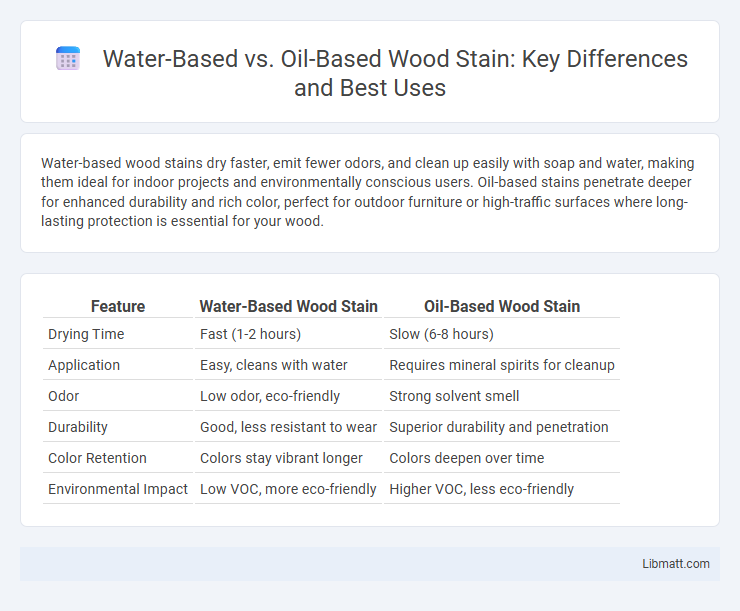Water-based wood stains dry faster, emit fewer odors, and clean up easily with soap and water, making them ideal for indoor projects and environmentally conscious users. Oil-based stains penetrate deeper for enhanced durability and rich color, perfect for outdoor furniture or high-traffic surfaces where long-lasting protection is essential for your wood.
Table of Comparison
| Feature | Water-Based Wood Stain | Oil-Based Wood Stain |
|---|---|---|
| Drying Time | Fast (1-2 hours) | Slow (6-8 hours) |
| Application | Easy, cleans with water | Requires mineral spirits for cleanup |
| Odor | Low odor, eco-friendly | Strong solvent smell |
| Durability | Good, less resistant to wear | Superior durability and penetration |
| Color Retention | Colors stay vibrant longer | Colors deepen over time |
| Environmental Impact | Low VOC, more eco-friendly | Higher VOC, less eco-friendly |
Introduction to Wood Stains
Wood stains enhance the natural beauty of wood while providing protection against moisture and UV damage. Water-based wood stains dry faster, emit lower VOCs, and offer easier cleanup, making them ideal for indoor projects and environmentally conscious users. Oil-based wood stains penetrate deeper, provide richer color, and offer better durability for outdoor furniture and high-traffic surfaces.
Understanding Water-Based Wood Stains
Water-based wood stains dry quickly and offer low odor and easy cleanup, making them ideal for indoor projects where ventilation is limited. These stains penetrate the wood fiber without raising the grain, enhancing natural texture and allowing for vibrant, long-lasting color. You can achieve a smooth finish while benefiting from environmentally friendly, low-VOC formulas that resist fading and yellowing over time.
Exploring Oil-Based Wood Stains
Oil-based wood stains offer deep penetration into wood fibers, enhancing durability and rich color development that resists wear and fading over time. Your choice of oil-based stains can improve moisture resistance and provide a longer-lasting finish compared to water-based alternatives. These stains require longer drying times but deliver superior protection and a classic, warm appearance ideal for high-traffic wood surfaces.
Key Differences: Water-Based vs Oil-Based Stains
Water-based wood stains dry faster and emit fewer volatile organic compounds, making them environmentally friendly and ideal for indoor use, while oil-based stains penetrate deeper for enhanced durability and richer color. Your choice depends on the desired finish, drying time, and maintenance requirements, as water-based stains offer easier cleanup with soap and water. Oil-based stains typically provide better protection against moisture and UV damage, making them suitable for exterior projects.
Application Process Comparison
Water-based wood stains dry faster, allowing for quicker recoating and project completion, and they clean up easily with soap and water. Oil-based wood stains penetrate deeper into the wood grain, providing richer color and longer drying times, requiring mineral spirits or paint thinner for cleanup. The application process for water-based stains often involves less odor and lower VOC emissions, making them more suitable for indoor use compared to oil-based stains.
Drying Time and Cleanup
Water-based wood stains typically dry within 1 to 2 hours, allowing for faster project completion and easier water cleanup using just soap and water. Oil-based stains require 6 to 24 hours to dry fully and need mineral spirits or paint thinner for cleanup, which can be more time-consuming and involve stronger chemicals. Choosing between water or oil-based stains affects your drying time and cleanup convenience, so consider your project timeline and preferred maintenance when making your decision.
Durability and Longevity
Water-based wood stains dry faster and resist fading, making them suitable for exterior surfaces requiring frequent maintenance, but they may need more frequent reapplication over time. Oil-based wood stains penetrate deeply into the wood grain, providing superior durability and longevity by protecting against moisture and wear, ideal for high-traffic areas and outdoor furniture. Your choice between water-based and oil-based stains depends on balancing quick drying needs with long-term protection requirements.
Environmental Impact and Safety
Water-based wood stains have a lower environmental impact due to their reduced volatile organic compounds (VOCs) content, making them safer for indoor use and less harmful to air quality. Oil-based stains typically contain higher VOC levels, contributing to air pollution and requiring proper ventilation during application to protect your health. Choosing water-based stains supports safer handling and a more eco-friendly finishing process for your wood projects.
Best Uses for Each Type
Water-based wood stains are ideal for projects requiring quick drying and easy cleanup, such as indoor furniture, cabinets, and trim, because they penetrate wood quickly and offer vibrant color retention. Oil-based stains are best suited for outdoor wood surfaces like decks, fences, and siding due to their superior durability, deep penetration, and resistance to weathering and wear. Your choice depends on the project's environment and desired finish longevity, ensuring optimal protection and aesthetic appeal.
How to Choose the Right Wood Stain for Your Project
Selecting the right wood stain depends on the project's requirements and desired finish. Water-based stains dry faster, offer low odor, and clean up easily with water, making them suitable for indoor projects or lighter wood tones. Oil-based stains penetrate deeply, enhance grain richness, and provide durable protection ideal for outdoor furniture or darker wood hues, ensuring your project achieves both aesthetic appeal and longevity.
Water-based vs oil-based wood stain Infographic

 libmatt.com
libmatt.com